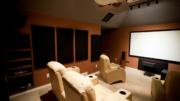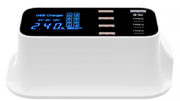Whether you are a performing artist or you are just a homeowner who enjoys the “home theater” experience, you want a sounding system that produces quality sound with both clarity and definition. Upcoming, low-budget recording artists need strong audio systems which together with DAW software and free Virtual Studio Technology instruments help them to make music at home without spending too much. With free virtual music tools such as free VST plugins, you no longer need a professional recording studio to take your sound to the next level.
But then, there are thousands of sound equipment out there designed for different audio output needs, which makes it extremely hard to know which equipment would work best for you. With that in mind, which things do you need to consider when buying a sounding system? Well, you will need to think about the system’s portability, the size of your audience, whether you will be using it indoors or outdoors, and the size of your budget. This article takes you through these and other key considerations you need to make when shopping for a new sounding system.
Theater or music room
The size of your music or theater room, or whichever room you will be using the sounding system in, will determine how big a speaker you need. As you can guess, big speakers are meant for small rooms while small speakers are ideal for small rooms. That is because big sounds in a small space load the environment with unwanted noises.
The type of room also matters in this regard. If the room is small but has one or multiple open sides (i.e. doesn’t have walls on all sides), a small speaker might not be ideal. Also, if the room is surrounded by soundproofing materials, it helps to distinguish what kind of sounding system to consider. Although big speakers take up lots of space in a small room, the existence of an open side would mean that most of the sound will be escaping the room, so it is unlikely that the room will be loaded with bass, muddy sound.
Type of speakers
Your speaker options include:
-
Surround system: This is a type of audio output that has multiple channels and speakers located all around a room such that a listener hears a sound coming from both in front and behind. The system creates a surrounding envelope of sound, a 360 degrees audio source. The system is a little pricey for an average budget, but it is the best option for a home theater system.
-
Soundbar or soundbar subwoofer: They integrate seamlessly into your TV and boost its audio system. Not as effective as a surround system, but they can be your better option if you intend to use the sound system in the living area instead of a designated home theater room.
-
Freestanding floor speakers: These speakers deliver great sound because they stand at a listener’s ear level. They are cheaper than soundbars but expensive than bookshelf speakers.
-
Bookshelf speakers: They are similar to floor speakers, except that they are cheaper and smaller. They can sit on tables and shelves. Their sound isn’t as great as any of the above options, but it is worth checking out if your audience is less than 20 people.
-
Subwoofers: Perfect for game nights and action movies due to their bass-pounding nature. They are small so you can place them in front of your TV or whichever visual display you got.
-
Portable speakers: These battery-operated, mostly wireless speakers are lightweight enough to be carried around within a home; within a specified radius.
Quality of sound
You probably have a preference for sound quality, so you should set your standards on this one. Sound quality is a perceptual reaction to a particular sounding system, after all.
Cost
Different sounding systems come at varied prices, so you can bet you will find a system for your budget. You should determine your budget beforehand to avoid the temptation of overspending. However, you need to have gone through the 3 steps above before settling on a budget because, as you may have established, expensive isn’t always the best, and affordable will in most cases have low-quality sound. You need an affordable sound system but it needs to have the desired sound performance.
Quality of the speakers
What is the frequency range of the sound your speaker of choice can emit? Quality speakers emit about 20-20,000 Hertz.
What is the sound’s sensitivity? The higher the sensitivity of a sounding system, the higher its volume will be per watt of power.
Do You Still Need A Receiver For A Home Theater System?
Simply put, a receiver is a component that allows you to connect your input devices to your output devices. Input devices, in this case, would be a DVD or CD player, games console, Blu-ray player, PVR among others. The output devices are the speakers or TV.
It is possible to connect the input and the output devices without a receiver. If, however, you want to improve the performance of your home theatre, you might want to reconsider. For starters, if you have multiple devices such as CD players and game consoles, a receiver allows easier switching between them. If you have to switch from one video source to another, for instance, you do it on the receiver without adjusting anything on your TV or output device. Secondly, a receiver comes with five channels of audio amplification. With that, it powers your speakers for the best surround sound, allowing you to enjoy soundtracks especially in a movie.
How to Select Home Theater Watts
When paired with the right speakers, a higher wattage output usually results in crispest, clearest sounds, and the capacity for more volume while maintaining clarity. Selecting the appropriate amount of watts that’ll provide high-quality sound from the home theater system can take your audio experience a notch higher. Here are tips to select the right home theater watts.
-
The Efficiency of the Speaker: Some speakers are extremely efficient, meaning they can generate a lot of clear sound on just a few watts. Others are less efficient and require a lot of watts to produce the same amount of sound. Features of efficient speakers include quality ports in the cabinet, horn-packed tweeters, and huge paper cones.
-
Room Size: The bigger your room, the more watts you’ll require to enjoy quality, sufficient volume. For an 18 x 18 feet room, with 9-foot ceilings, a home theater with 25 watts/channel will do the trick, but the speakers must be efficient. If the speakers are non-efficient, go for 40 watts/channel home theater.
-
Music-Type: If you enjoy listening to loud music, a home theater with 125 watts/per channel will be a perfect choice for your 18 x 18- foot room.
Which Home Theater Brand is the Best?
The best home theater brand can offer you tons of hours of entertainment in many forms, from streaming your favorite TV shows and movies from different sites to listening to your favorite songs. The Onkyo HT-S7800 5.1.2 is the best home theater brand due to its powerful performance, outstanding Dolby Atmos support, and budget-friendly cost. As a home theater in a box (HTIB), this Onkyo brand comes with all the audio gears you’ll require to assemble a full Dolby Atmos entertainment system. It features 115 watts per channel receiver that hooks up all media players and transmits video to the TV through an HDMI cable.
Final words
The bottom line is to always find a system that works best for your room size, which produces your preferred sound quality, that doesn’t inflate your power bills, and that goes slow on your wallet.





